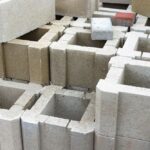A concrete mix ratio is the ratio of quantities of cement, sand, aggregates, and water to be used for mixing by volume or weight. This mix ratio depends on the grade of concrete to be used based on the mix design and type of construction. In the absence of a mix design to find the ratio of concrete mix, standard building codes provides nominal and standard concrete mix ratios for various construction activities. These types of concrete mixes have been derived based on a number of years of experience and testing of concrete.
Also Read: Calculate Cement, Sand, Aggregate Quantity in Concrete
American Concrete Institute (ACI) standard code specifies concrete grade concrete mix 1000, concrete mix 2000, concrete mix 3000, concrete mix 4000, concrete mix 5000, concrete mix 6000, concrete mix 8000. For concrete mix 3000, the number represents the compressive strength of concrete in psi. This is the strength of the concrete cylinder of 6in diameter and 12in height tested after 28 days on the compression testing machine.

Types of Concrete Mix Ratio and Grades
There are three basic types of concrete mix ratio:
1. Nominal Concrete Mix Ratio
Nominal concrete mixe ratios are those which have been used based on past experiences in the locality which ensures adequate strength of concrete. The ratio of cement, sand, aggregates, and water varies from location to location based on environmental conditions. There is no minimum strength requirement for the nominal mixes specified and it is used only to get sufficient strength for the purpose.
The nominal mix ratio may offer a high margin of strength or less strength than required, due to no measurement of strength and poor workmanship at construction sites. But these mixes may prove to be costly if it is used for mass concreting.
2. Standard Concrete Mix Ratio
The nominal concrete mix of fixed cement-aggregate ratio may vary widely in strength and may result in under or over-rich mixes. For this reason, the minimum compressive strength has been specified for each mixing ratio and these are called the standard mix ratio which has been derived based on experience and testing.
A standard concrete mix ratio is used for concrete grades of 750 psi (M5) 1000 psi (M7.5), 1500 psi (M10), 2000 psi (M15), 3000 psi (M20).
The standard concrete mix ratio for different strength requirements are:
| Concrete Strength | Nominal Concrete Mix Ratio |
| 750 psi (M5) | 1:5:10 |
| 1000 psi (M7.5) | 1:4:8 |
| 1500 psi (M10) | 1:3:6 |
| 2000 psi (M15) | 1:2:4 |
| 3000 psi (M20) | 1:1.5:3 |
| 3600 psi (M25) | 1:1:2 |
3. Designed Concrete Mix Ratio
In the designed concrete mixe ratio, the strength of the concrete is specified by the structural designer but the mix proportions are determined by the concrete manufacturer based on testing, except when the minimum cement content requirement is greater than the design mix based on testing.
The design mix ratio is the most rational approach to the selection of mix proportions. Suitable admixtures and other ingredients can also be added to the designed mix concrete which results in the production of concrete with the required strength and properties.
The designed concrete ratio is economical as the ratio has been designed based on testing to get the required strength. But the quality control at concrete mixing and construction site is required to get the desired output strength. This mix ratio is used for mass concrete works and large construction projects where it gives cost savings on materials.
The designed concrete mix ratio for different strength requirements are:
| Concrete Strength | Nominal Concrete Mix Ratio |
| 4000 psi (M30) | As per the design mix |
| 5000 psi (M35) | As per the design mix |
| 6000 psi (M40) | As per the design mix |
| 7000 psi (M50) | As per the design mix |
| 8000 psi (M60) | As per the design mix |
| 10000 psi (M70) | As per the design mix |
So, the following are the estimated concrete mix ratio for various concrete strengths in psi:
Concrete mix 750 psi – ratio 1:5:10
Concrete mix 1000 psi – ratio (M7.5) 1:4:8
Concrete mix 1500 psi – ratio (M10) 1:3:6
Concrete mix 2000 psi – ratio (M15) 1:2:4
Concrete mix 3000 psi – ratio (M20) 1:1.5:3
Concrete mix 3600 psi – ratio (M25) 1:1:2
Water-Cement Ratio and Compressive Strength Relationship (ACI, 2000)
| 28-Day Compressive Strength in psi | Water-cement ratio by weight |
| 2000 (M15) | 0.82 |
| 3000 (M20) | 0.68 |
| 4000 (M30) | 0.57 |
| 5000 (M35) | 0.48 |
| 6000 (M40) | 0.41 |
Refer to ACI Manual of Concrete Practice 2000, Part 1: Materials and General Properties of Concrete. American Concrete Institute. Farmington Hills, MI.
Read More: 26 Types of Concrete Mixes with Uses in Construction




